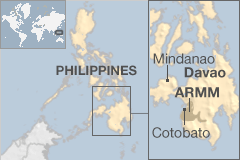Mindanao stories: What will peace bring?
- Published
Mindanao is a beautiful island in the southern Philippines - yet in and around the city of Cotabato there are several rebel groups, extortion gangs, and clans with their own private armies. There are also tens of thousands of people trying to live a normal life. The main rebel group signed a roadmap for peace with the government in 2012. What will this mean for those living there?
-
Life displaced
Abdul Manan Manalasal is now in his forties, but he's been unable to live on his family's lands since childhood.
He's one of hundreds of thousands of people to have been displaced because of the violence - either by clan feuds, or fighting between the government and rebel forces. Some of these displaced people are now in official camps, reliant on aid from charities and the government. Many others, like Mr Manaladal, move from place to place, trying to eke out a living on spare bits of land.
-
Soldier's story
Aurelio Rakinton is a sergeant in the Philippine Army's 6th Infantry Division. He's in charge of a team guarding the main road to Cotabato's airport.
He's been based in different parts of central Mindanao for the past two decades, and he's seen active fighting against the Moro Islamic Liberation Front and other rebel groups.
-
Rebel cause
Habir Bansil is a rebel fighter for the Moro Islamic Liberation Front (Milf), the group which has just signed a peace deal with the government, and under the terms of the deal will gradually be disarmed.
He joined the movement at the age of 18 - and now, 20 years later, he has no regrets about his decision. He spends most of his time living in the rebels' jungle hideouts in the mountains of central Mindanao.
-
From the front line
Nash Maulana is the Mindanao reporter for the Philippine Daily Inquirer, one of the country's main newspapers.
Statistics show that the Philippines is one of the most dangerous countries to be a journalist and this is especially true in Mindanao - where reporters tread a delicate path between government officials, soldiers, several different rebel groups and influential clans.
-
Blood ties
Esmael Mangudadatu is the governor of Maguindanao province, just south of Cotabato City and one of the most troubled parts of the region.
Not only are rebels known to operate in Maguindanao, it was also the scene of one of the worst massacres in Philippine history - a crime attributed to the long-standing family feuds in the area. Members of the Ampatuan family are currently on trial for the murders - the victims included members of Mr Mangudadatu's own family.
-
Business as usual
Bai Sandra Basar-Siang owns two shops in Cotabato City, and employs more than 20 people
Her business has stayed open through some of the most difficult times in the conflict - during active fighting, government-imposed curfews and even when many of her customers were forced to flee their homes and relocate elsewhere.

- Population of Cotabato + semi-autonomous Muslim region (ARRM): 3.5 million
- Majority Muslim, while Philippine population is 85% Catholic
- Islamic rebel activity for almost 40 years
- Lower GDP, infant mortality and literacy rates than rest of the Philippines
Produced by: Kate McGeown, Alice Budisatrijo, Emily Jones and Steven Atherton.





